Contents
Articles
2025
- Google Play Protect is now the custom DPC gatekeeper, and everyone is a threat by default
- 12 deliveries of AE-mas (What shipped in Android Enterprise in 2025)
- The 12 AE requests of Christmas (2025 Edition)
- RCS Archival and you: clearing up the misconceptions
- Device Trust from Android Enterprise: What it is and how it works (hands-on)
- Android developer verification: what this means for consumers and enterprise
- AMAPI finally supports direct APK installation, this is how it works
- The Android Management API doesn't support pulling managed properties (config) from app tracks. Here's how to work around it
- Hands-on with CVE-2025-22442, a work profile sideloading vulnerability affecting most Android devices today
- AAB support for private apps in the managed Google Play iFrame is coming, take a first look here
- What's new (so far) for enterprise in Android 16
2024
- Android 15: What's new for enterprise?
- How Goto's acquisition of Miradore is eroding a once-promising MDM solution
- Google Play Protect no longer sends sideloaded applications for scanning on enterprise-managed devices
- Mobile Pros is moving to Discord
- Avoid another CrowdStrike takedown: Two approaches to replacing Windows
- Introducing MANAGED SETTINGS
- I'm joining NinjaOne
- Samsung announces Knox SDK restrictions for Android 15
- What's new (so far) for enterprise in Android 15
- Google quietly introduces new quotas for unvalidated AMAPI use
- What is Play Auto Install (PAI) in Android and how does it work?
- AMAPI publicly adds support for DPC migration
- How do Android devices become certified?
2023
- Mute @channel & @here notifications in Slack
- A guide to raising better support requests
- Ask Jason: How should we manage security and/or OS updates for our devices?
- Pixel 8 series launches with 7 years of software support
- Android's work profile behaviour has been reverted in 14 beta 5.3
- Fairphone raises the bar with commitment to Android updates
- Product files: The DoorDash T8
- Android's work profile gets a major upgrade in 14
- Google's inactive account policy may not impact Android Enterprise customers
- Product files: Alternative form factors and power solutions
- What's new in Android 14 for enterprise
- Introducing Micro Mobility
- Android Enterprise: A refresher
2022
- What I'd like to see from Android Enterprise in 2023
- Thoughts on Android 12's password complexity changes
- Google Play target API requirements & impact on enterprise applications
- Sunsetting Discuss comment platform
- Google publishes differences between Android and Android Go
- Android Go & EMM support
- Relaunching bayton.org
- AER dropped the 3/5 year update mandate with Android 11, where are we now?
- I made a bet with Google (and lost)
2020
- Product files: Building Android devices
- Google announce big changes to zero-touch
- VMware announces end of support for Device Admin
- Google launch the Android Enterprise Help Community
- Watch: An Android Enterprise discussion with Hypergate
- Listen again: BM podcast #144 - Jason Bayton & Russ Mohr talk Android!
- Google's Android Management API will soon support COPE
- Android Enterprise in 11: Google reduces visibility and control with COPE to bolster privacy.
- The decade that redefined Android in the enterprise
2019
- Why Intune doesn't support Android Enterprise COPE
- VMware WS1 UEM 1908 supports Android Enterprise enrolments on closed networks and AOSP devices
- The Bayton 2019 Android Enterprise experience survey
- Android Enterprise Partner Summit 2019 highlights
- The Huawei ban and Enterprise: what now?
- Dabbling with Android Enterprise in Q beta 3
- Why I moved from Google WiFi to Netgear Orbi
- I'm joining Social Mobile as Director of Android Innovation
- Android Enterprise in Q/10: features and clarity on DA deprecation
- MWC 2019: Mid-range devices excel, 5G everything, form-factors galore and Android Enterprise
- UEM tools managing Android-powered cars
- Joining the Android Enterprise Experts community
- February was an interesting month for OEMConfig
- Google launch Android Enterprise Recommended for Managed Service Providers
- Migrating from Windows 10 Mobile? Here's why you should consider Android
- AER expands: Android Enterprise Recommended for EMMs
- What I'd like to see from Android Enterprise in 2019
2018
- My top Android apps in 2018
- Year in review: 2018
- MobileIron Cloud R58 supports Android Enterprise fully managed devices with work profiles
- Hands on with the Huawei Mate 20 Pro
- Workspace ONE UEM 1810 introduces support for Android Enterprise fully managed devices with work profiles
- G Suite no longer prevents Android data leakage by default
- Live: Huawei Mate series launch
- How to sideload the Digital Wellbeing beta on Pie
- How to manually update the Nokia 7 Plus to Android Pie
- Hands on with the BQ Aquaris X2 Pro
- Hands on with Sony OEMConfig
- The state of Android Enterprise in 2018
- BYOD & Privacy: Don’t settle for legacy Android management in 2018
- Connecting two Synologies via SSH using public and private key authentication
- How to update Rsync on Mac OS Mojave and High Sierra
- Intune gains support for Android Enterprise COSU deployments
- Android Enterprise Recommended: HMD Global launch the Nokia 3.1 and Nokia 5.1
- Android Enterprise Partner Summit 2018 highlights
- Live: MobileIron LIVE! 2018
- Android Enterprise first: AirWatch 9.4 lands with a new name and focus
- Live: Android Enterprise Partner Summit 2018
- Samsung, Oreo and an inconsistent Android Enterprise UX
- MobileIron launch Android Enterprise work profiles on fully managed devices
- Android P demonstrates Google's focus on the enterprise
- An introduction to managed Google Play
- MWC 2018: Android One, Oreo Go, Android Enterprise Recommended & Android Enterprise
- Enterprise ready: Google launch Android Enterprise Recommended
2017
- Year in review: 2017
- Google is deprecating device admin in favour of Android Enterprise
- Hands on with the Sony Xperia XZ1 Compact
- Moto C Plus giveaway
- The state of Android Enterprise in 2017
- Samsung launched a Note 8 for enterprise
- MobileIron officially supports Android Enterprise QR code provisioning
- Android zero-touch enrolment has landed
- MobileIron unofficially supports QR provisioning for Android Enterprise work-managed devices, this is how I found it
- Hands on with the Nokia 3
- Experimenting with clustering and data replication in Nextcloud with MariaDB Galera and SyncThing
- Introducing documentation on bayton.org
- Goodbye Alexa, Hey Google: Hands on with the Google Home
- Restricting access to Exchange ActiveSync
- What is Mobile Device Management?
- 8 tips for a successful EMM deployment
- Long-term update: the fitlet-RM, a fanless industrial mini PC by Compulab
- First look: the FreedomPop V7
- Vault7 and the CIA: This is why we need EMM
- What is Android Enterprise (Android for Work) and why is it used?
- Introducing night mode on bayton.org
- What is iOS Supervision and why is it used?
- Hands on with the Galaxy TabPro S
- Introducing Nextcloud demo servers
- Part 4 - Project Obsidian: Obsidian is dead, long live Obsidian
2016
- My top Android apps 2016
- Hands on with the Linx 12V64
- Wandera review 2016: 2 years on
- Deploying MobileIron 9.1+ on KVM
- Hands on with the Nextcloud Box
- How a promoted tweet landed me on Finnish national news
- Using RWG Mobile for simple, cross-device centralised voicemail
- Part 3 – Project Obsidian: A change, data migration day 1 and build day 2
- Hands on: fitlet-RM, a fanless industrial mini PC by Compulab
- Part 2 - Project Obsidian: Build day 1
- Part 1 - Project Obsidian: Objectives & parts list
- Part 0 - Project Obsidian: Low power NAS & container server
- 5 Android apps improving my Chromebook experience
- First look: Android apps on ChromeOS
- Competition: Win 3 months of free VPS/Container hosting - Closed!
- ElasticHosts review
- ElasticHosts: Cloud Storage vs Folders, what's the difference?
- Adding bash completion to LXD
- Android N: First look & hands-on
- Springs.io - Container hosting at container prices
- Apple vs the FBI: This is why we need MDM
- Miradore Online MDM: Expanding management with subscriptions
- Lenovo Yoga 300 (11IBY) hard drive upgrade
- I bought a Lenovo Yoga 300, this is why I'm sending it back
- Restricting access to Exchange ActiveSync
- Switching to HTTPS on WordPress
2015
2014
- Is CYOD the answer to the BYOD headache?
- BYOD Management: Yes, we can wipe your phone
- A fortnight with Android Wear: LG G Watch review
- First look: Miradore Online free MDM
- Hands on: A weekend with Google Glass
- A month with Wandera Mobile Gateway
- Final thoughts: Dell Venue Pro 11 (Atom)
- Thoughts on BYOD
- Will 2014 bring better battery life?
- My year in review: Bayton.org
- The best purchase I've ever made? A Moto G for my father
2013
2012
- My Top Android Apps 12/12
- The Nexus 7 saga: Resolved
- Recycling Caps Lock into something useful - Ubuntu (12.04)
- The Nexus 7 saga continues
- From Wows to Woes: Why I won't be recommending a Nexus7 any time soon.
- Nexus7: What you need to know
- Why I disabled dlvr.it links on Facebook
- HTC Sense: Changing the lockscreen icons from within ADW
2011
- Push your Google+ posts to Twitter and Facebook
- Using multiple accounts with Google.
- The "Wn-R48" (Windows on the Cr-48)
- Want a Google+ invite?
- Publishing to external sources from Google+
- Dell Streak review. The Phone/Tablet Hybrid
- BlueInput: The Bluetooth HID driver Google forgot to include
- Pushing Buzz to Twitter with dlvr.it
- Managing your social outreach with dlvr.it
- When Awe met Some. The Cr-48 and Gnome3.
- Living with Google's Cr-48 and the cloud.
- Downtime 23-25/04/2011
- Are you practising "safe surfing"?
- The Virtualbox bug: "Cannot access the kernel driver" in Windows
- Putting tech into perspective
2010
- Have a Google Buzz Christmas
- Root a G1 running Android 1.6 without recovery!
- Windows 7 display issues on old Dell desktops
- Google added the Apps flexibility we've been waiting for!
- Part I: My 3 step program for moving to Google Apps
- Downloading torrents
- Completing the Buzz experience for Google Maps Mobile
- Quicktip: Trial Google Apps
- Quicktip: Save internet images fast
- Turn your desktop 3D!
- Part III - Device not compatible - Skype on 3
- Swype not compatible? ShapeWriter!
- Don't wait, get Swype now!
- HideIP VPN. Finally!
- Google enables Wave for Apps domains
- Aspire One touch screen
- Streamline XP into Ubuntu
- Edit a PDF with Zamzar
- Google offering Gmail addresses in the UK
- Google Wave: Revolutionising blogs!
- Hexxeh's Google Chrome OS builds
- Update: Buzz on Windows Mobile
- Alternatives to Internet Explorer
- Wordress 3.0 is coming!
- Skype for WM alternatives
- Browsing on a (data) budget? Opera!
- Buzz on unsupported mobiles
- Buzz on your desktop
- What's all the Buzz?
- Part II: Device not compatible - Skype on 3
- Part I - Device not compatible - Skype on 3
- Dreamscene on Windows 7
- Free Skype with 3? There's a catch..
Android Enterprise Partner Summit 2019 highlights
Contents
Much like 2018, I’d been waiting for the Summit to come around all year. It’s by far my favourite event not only for the content, but the ability to sit down with Googlers, with partners and everyone else in the Android Ecosystem to have proper, in-depth conversations about Android in (and out of) the enterprise.
One of the overall highlights is meeting folks who’ve followed my content over the years. From Europe to the US, JAPAC and more, there’s no event where I shake more hands and get to talk with more people who’ve leveraged my content to bring their own projects to fruition. It’s truly humbling and incredibly motivational!
To preface the following, it’s taken a good while for me to put something together primarily because I’d been waiting on the slides and content promised for release the week following the summit to arrive. They still haven’t, nor have I been able to get hold of anything outside of official channels. Because I’d missed a few sessions given the split of GTM and Technical, the highlights I post are based primarily on what I saw.
Google also worked hard to make clear what was NDA this year, including, for whatever reason, the Android Enterprise stats I shared last year. As such, some of the stuff that I’d normally refer to in order to show how incredibly well Android Enterprise is doing in the industry I cannot. Go figure.
With that out of the way, lets get into it!
It wasn’t all new
#As expected sitting on the bleeding edge of Android Enterprise, there was a fair bit of content I’d already seen or written about over the year. That isn’t to suggest the content wasn’t new to many others (my LinkedIn feed was blowing up!), but topics around zero-touch, the Play iFrame, DA migration, Samsung’s OEMConfig and so on were all very much covered through the year.
In fact, if you’re not familiar with my documentation, please take an opportunity to head on over to /android for a gander, you’ll arguably get far more information out of those docs than this recap of the summit!
But plenty was
#Android Enterprise continues to grow at an incredibly rapid pace. Despite not being able to share the newest slide that offers little more than the upwards indicator (I refer back to last year’s “10x growth” of something) to back up my statement, Android as a platform has increasingly dominated the enterprise market over the last year and the uptick in AE adoption is an obvious side effect; one of those reasons I can state is the rugged market which Microsoft still has a stake in, as demonstrated by the slide:
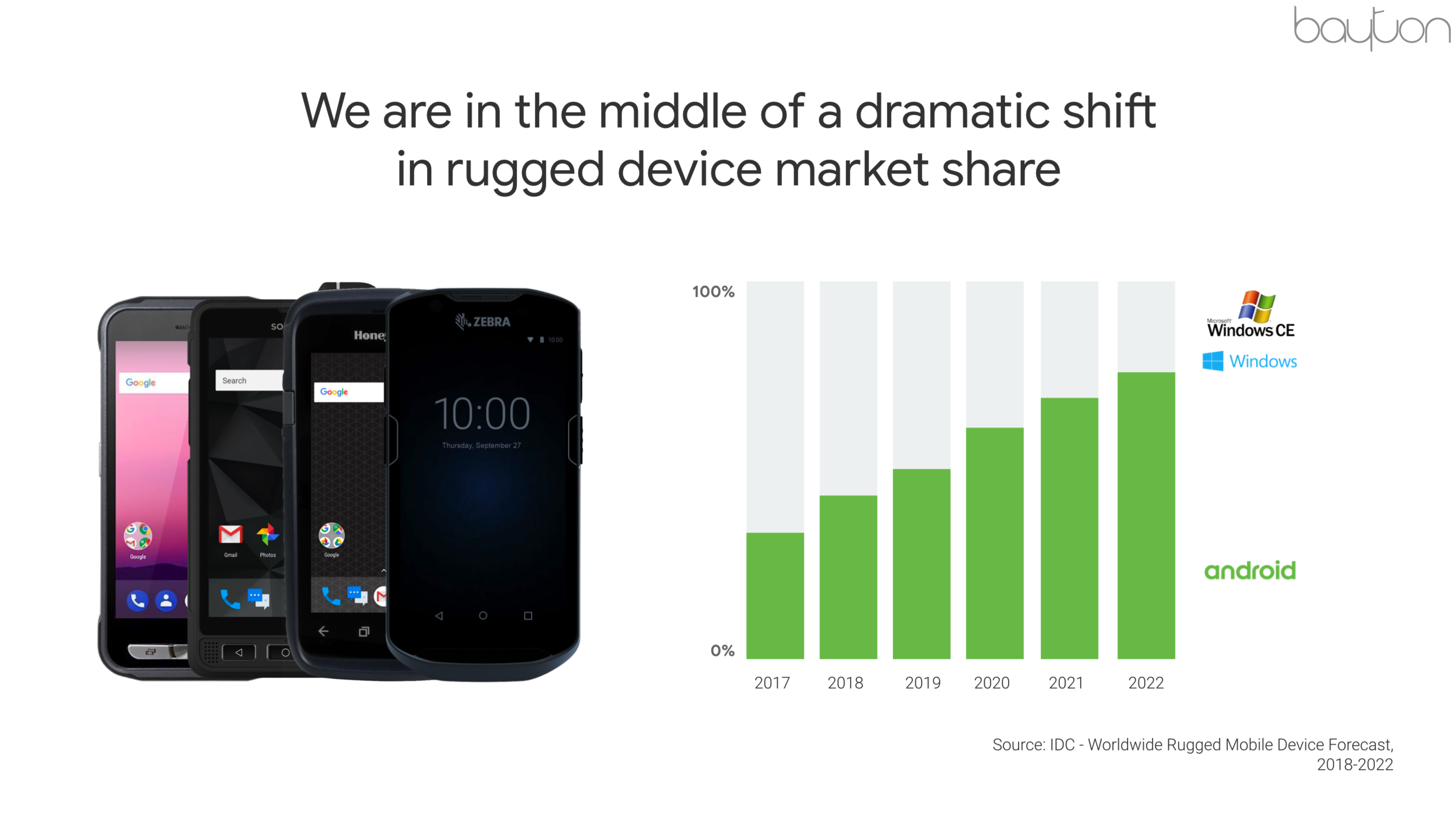
As 2020 approaches and more organisations finally, with full justification, give up on Windows 10 Mobile, Windows Phone, Windows CE and other versions of Microsoft’s Mobile OS, Android is the clear choice. Why?
- Form factor
- Budget
- Flexibility
Android fills the void left by Microsoft very well, and subsequently improves it in almost every way.
Stats
#Android patching: In Q4 2018, 84% more devices were patched compared to the same time a year prior. 2017 already being a pretty good year for patches with a 30% increase on 2016, it’s extremely telling just how much energy has been directed towards this space. Through programmes like AER, Android One and a generally wider acknowledgement of how important patching is both in the enterprise and consumer space, the stats now speak for themselves.
Play Protect: Now protecting 2.5 billion devices, Play Protect continues to analyse 500K and verify 50 billion applications every day.
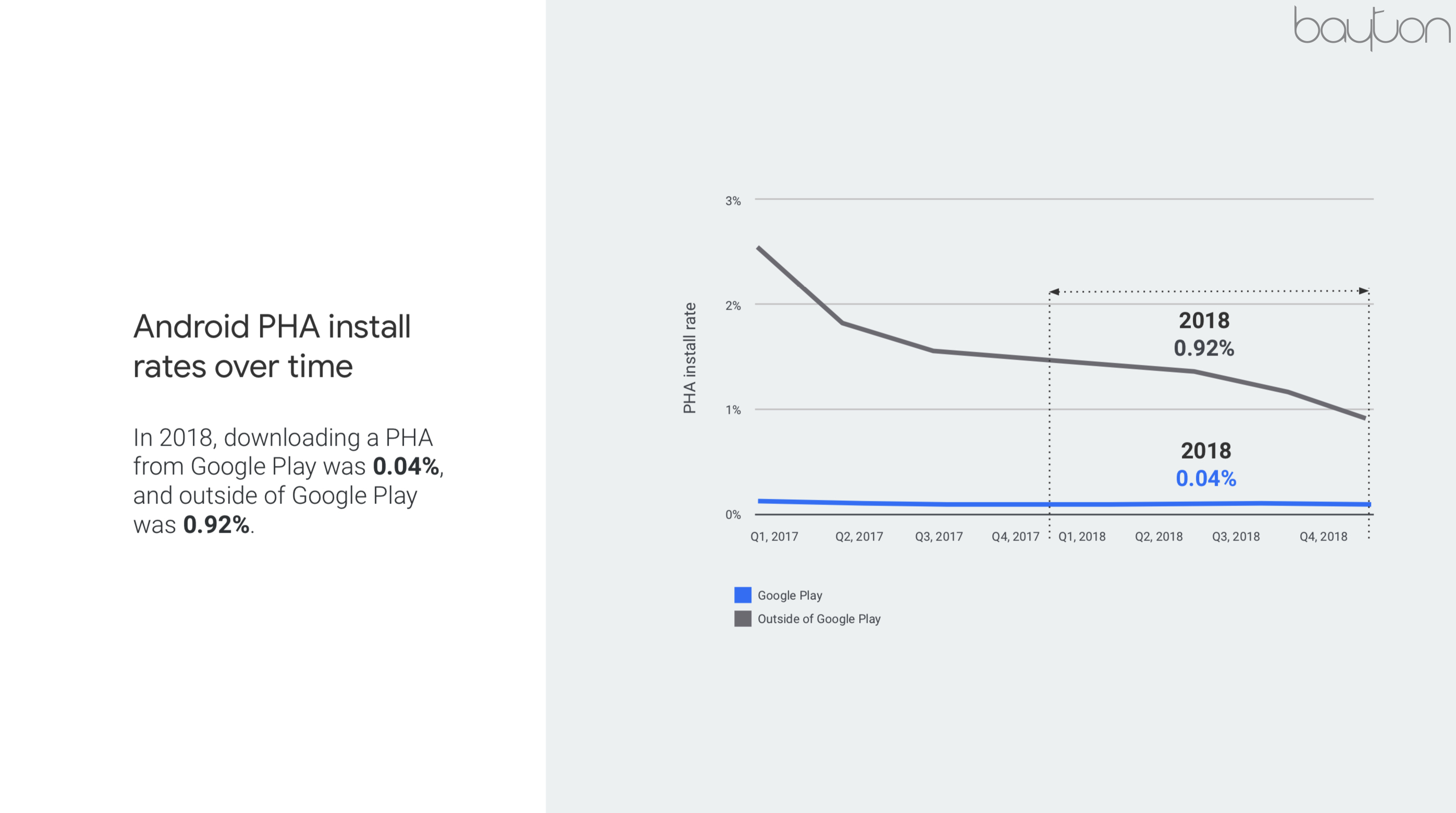
Admittedly the rate of infection has increased over 2017, however the figures are still impressively low. This is and always will be a moving target, so depending on when the stats are collected this can be higher or lower, the Android Ecosystem Security Transparency Report goes into a lot more detail on these stats.
Zero-touch growth: In the last year the number of zero-touch resellers has grown to 116, with many more still to come in 2019. The big news in the reseller space was the introduction of the common library with Samsung back at MWC. The number of devices that support zero-touch now dwarfs the 30-odd last year also.
Growth in awareness of Android Enterprise Recommended: Google leveraged a report undertaken by HMD Global (Nokia) in 2018 available in full here to demonstrate how well AER is doing just a year after launch:
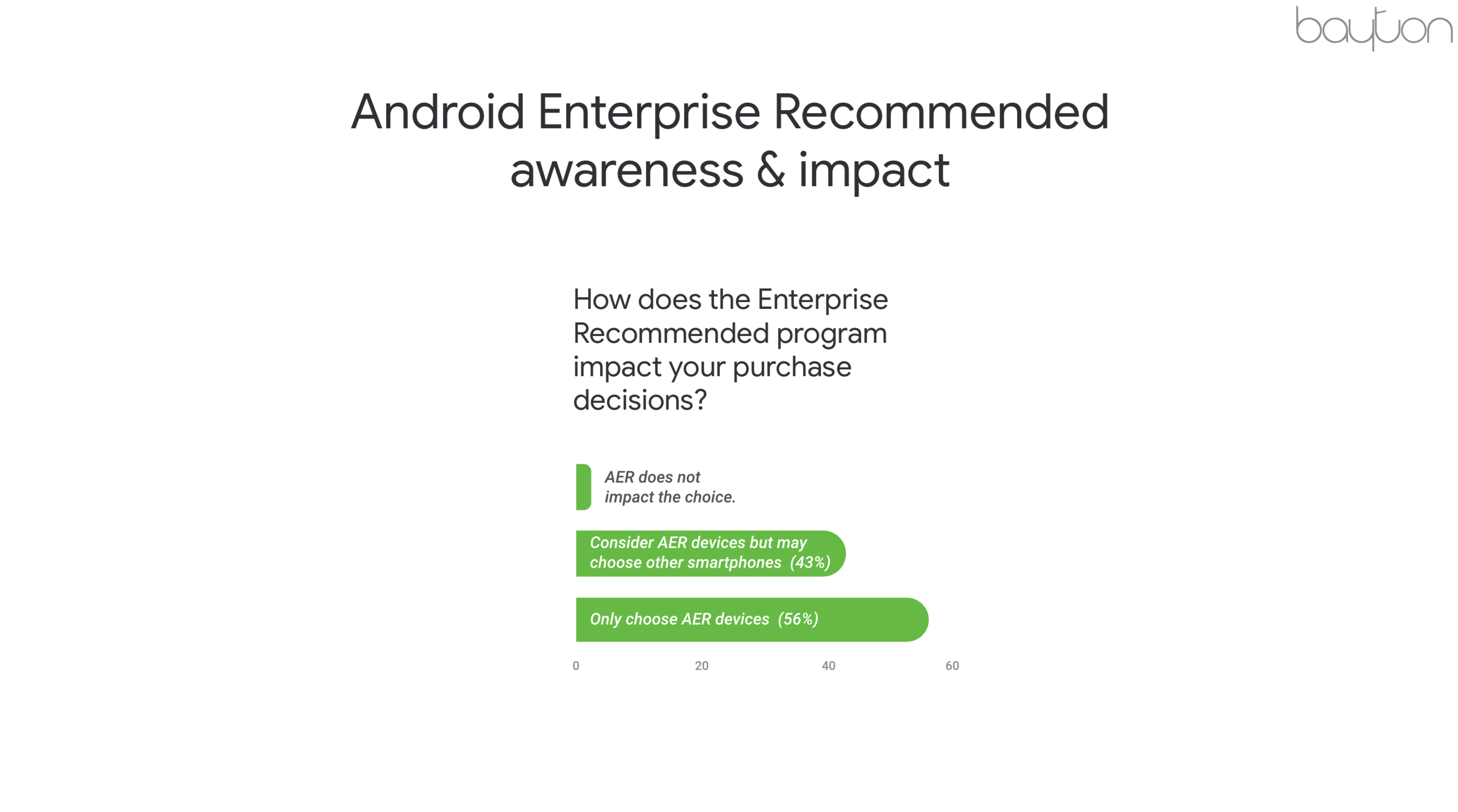
With 18 OEMs and 75+ devices, the AER devices programme has grown too! AER also launched for EMMs and MSPs, with the Android Enterprise Experts validation program boasting 133 validated experts in the first run:
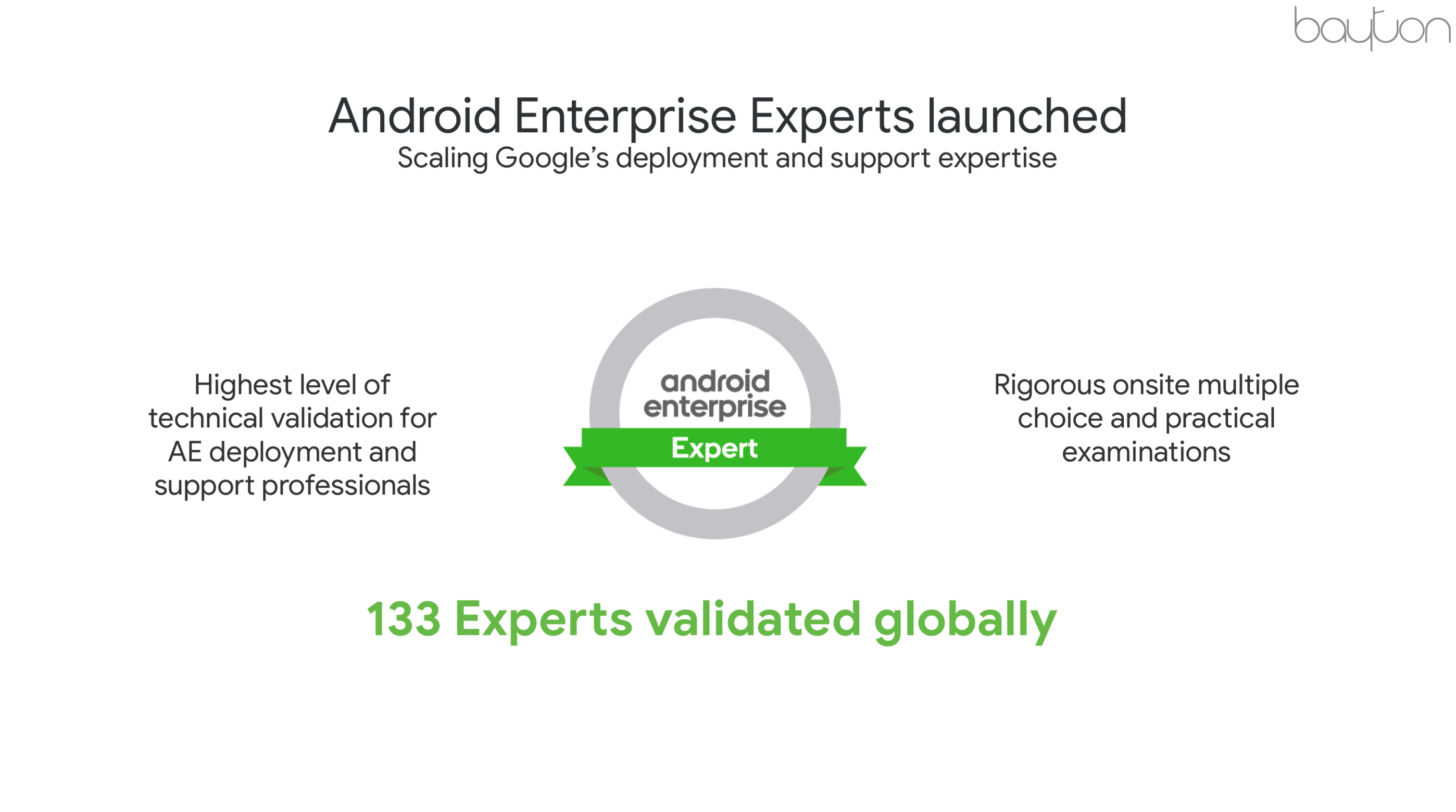
The Android Management API
#AMAPI was an enormous focus of the event, taking up a good bit of my time across the two days. In a nutshell:
AMAPI is now out of beta: With its rapid pace of development and the fact there’s little front-end marketing of AMAPI within EMM solutions, it would have been easy to assume AMAPI left beta a while ago, but no! AMAPI came out of beta during the summit.
COPE support is coming soon: A huge deal not only for AMAPI itself (finally, only 2 years after Oreo) but all of the EMMs today waiting on said support. Intune is definitely the biggest name to embrace AMAPI today and the MS team there must have been as pleased as me to get confirmation.
It’s going native: AMAPI is ditching the dedicated app icon on the launcher for an integrated feeling within device settings. Combined with becoming a part of GMS-optional (a list of optional applications OEMs can bundle on a device alongside Core GMS apps), AMAPI is going to feel almost as native as Windows and iOS.
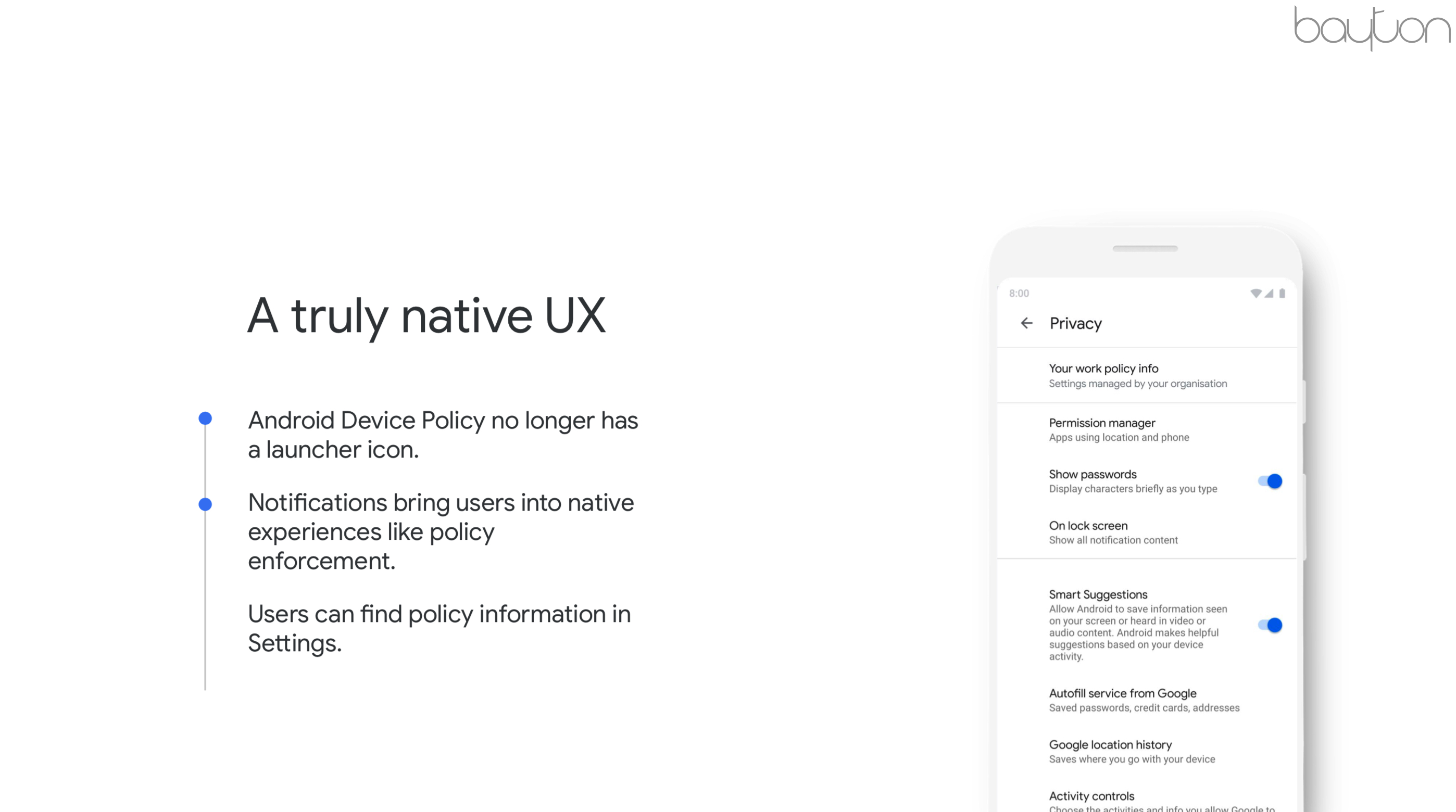
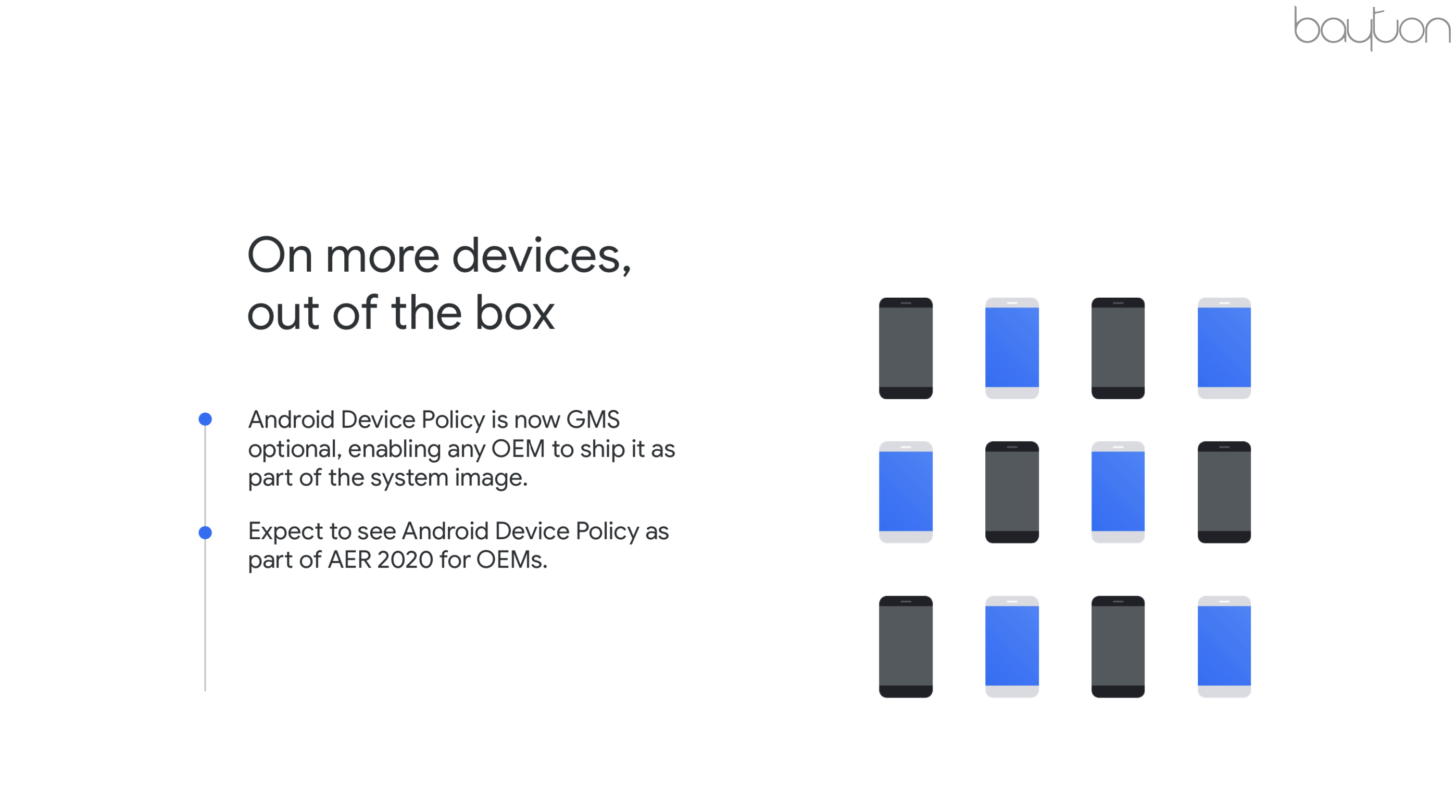
Being Android it’s still app-driven, and will continue to receive updates through Google Play, but irrespective of this, when users look to understand the policies enforced on the device, as well as the privacy impact of said policies, it’ll all be available by navigating to Settings on the device.
Wider SSO capabilities: To further assist vendors in developing as little as possible when integrating AMAPI, it has been expanded to support authentication through multiple IDPs.
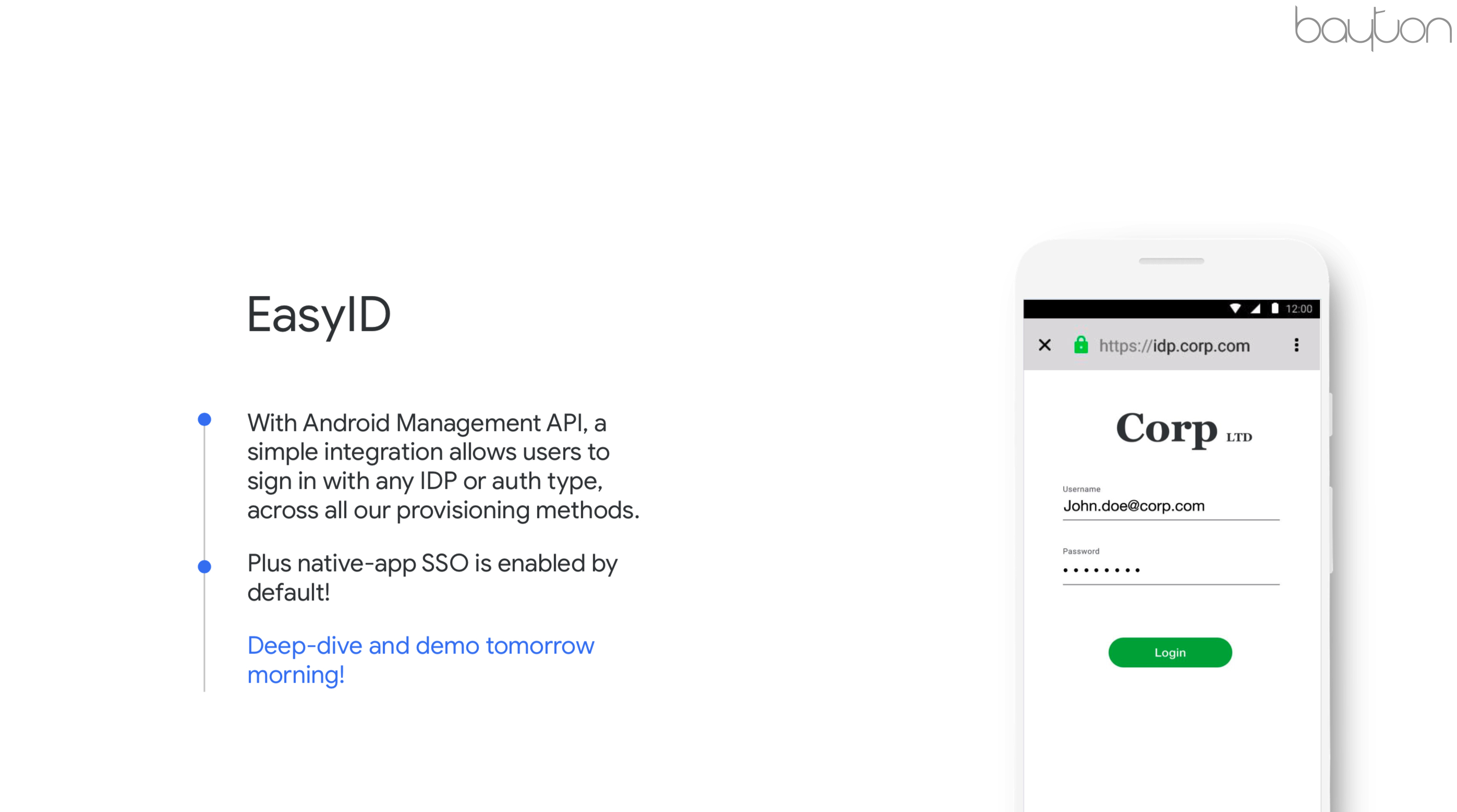
Supporting differentiation: I’ve had plenty of conversations about AMAPI and in implications of going all-in. “How do we stand out?”. AMAPI will support extensibility to promote EMM differentiation by allowing vendors to build out custom features. Some of the examples offered were custom compliance policies, geofencing, and more.
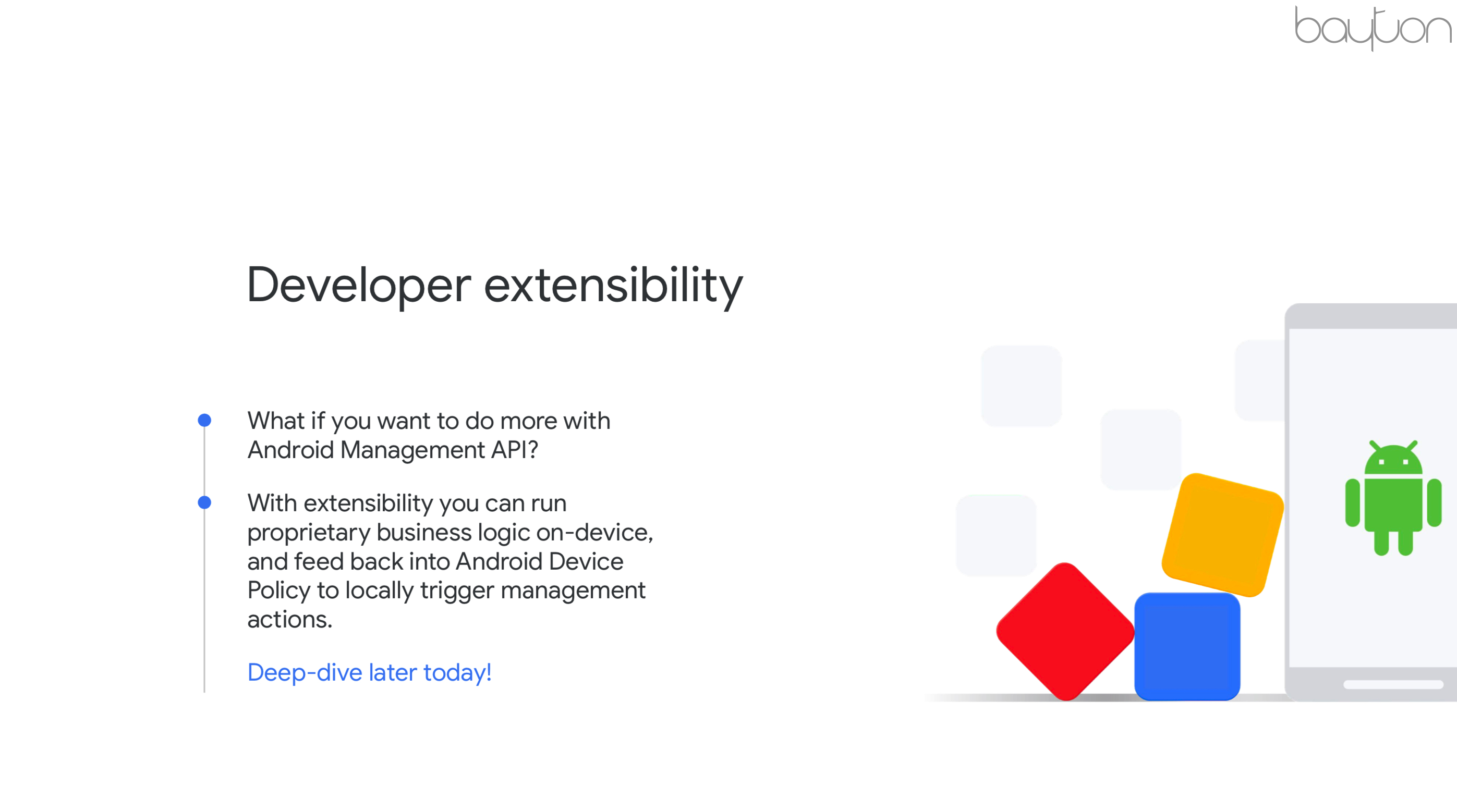
Vendors will no longer be limited by Google on when (if ever) some functionality will be supported, with support for extensibility vendors can jump right in and build something themselves. It’s very much like the OEMConfig of AMAPI.
Smart system app management: Google see system app management as a chore. Something that’s difficult to manage, rarely consistent across OEMs and generally in need of improvement. They’ve introduced smart system apps to automatically “enable the right system apps for every device”.
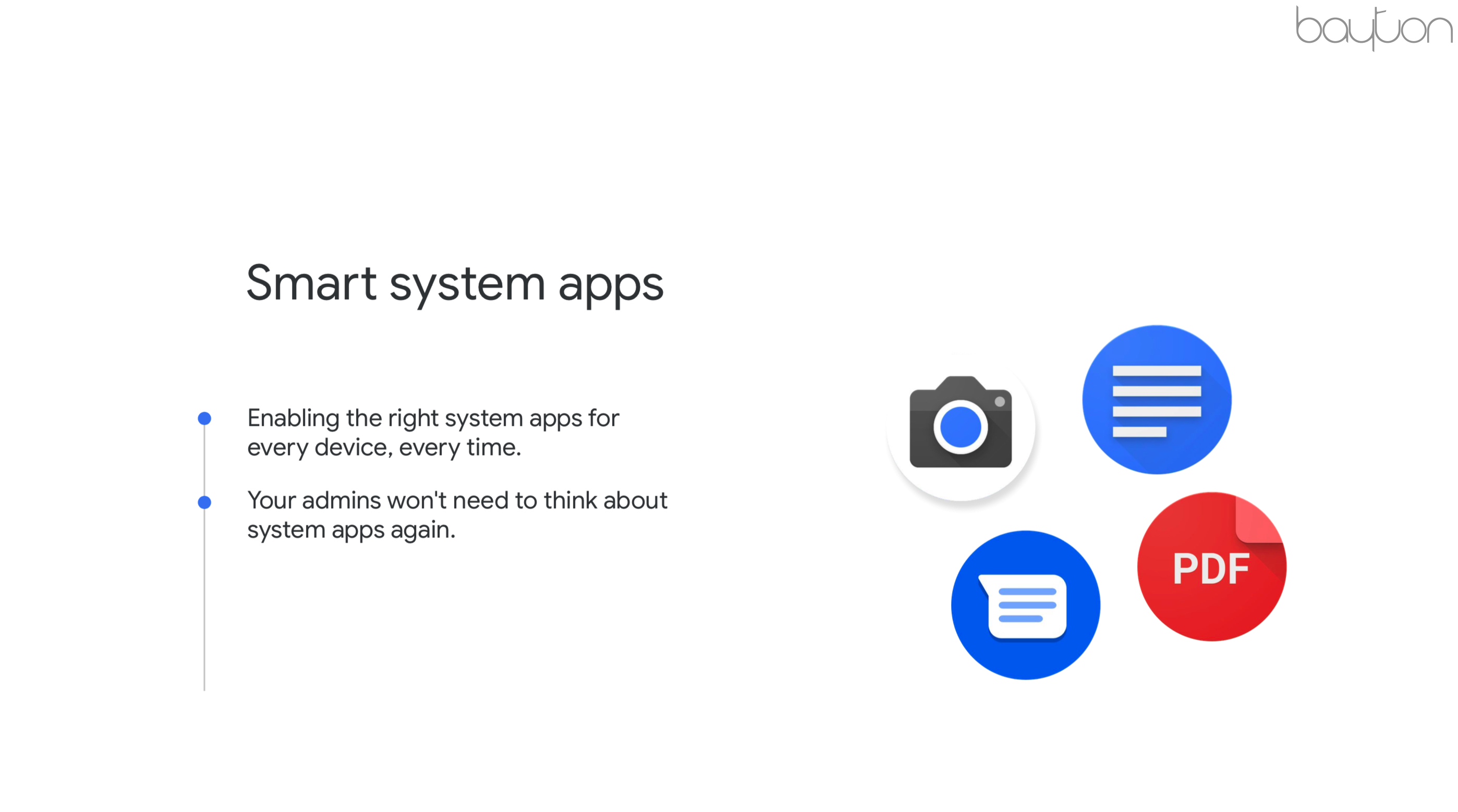
I like the idea in theory, but frankly system app management has rarely been an issue for me (in the wider context of deployments I’ve undertaken over the years), and I’d much rather have manual control than rely on some algorithm to determine what to enable on my behalf. I’d super appreciate if Google would just give me the fine-grained control I’ve had with Play EMM API for years. Please and thank you!
Improvements to managed config
#Managed config is one of the best features of Android Enterprise. That a developer can expose settings to be configured remotely that automatically appear within an EMM for admins to configure is pretty marvellous!
But it’s not perfect.
Managed config offers little in the way of feedback, has been occasionally unreliable on some devices in some situations, failing to update configs pushed out any more.
Google offered a nice few announcements on how this will improve.
App feedback channel: A limitation of managed config to date has been the one-sidedness of it all. An admin will add and distribute configuration, and then it probably applies. I say probably because unless you have the device in front of you it’s hard to say.

The app feedback channel offers a means for bidirectional communication. Admins can query the state at any point and get a response to confirm a managed config has executed, whether that’s an app or OEMConfig.
Update broadcast: Equally trying over the years has been the perception that managed configs just don’t update in a timely fashion. I’ve personally had situations where it can take hours for a change to reflect in Gmail for example. Update broadcast should help.
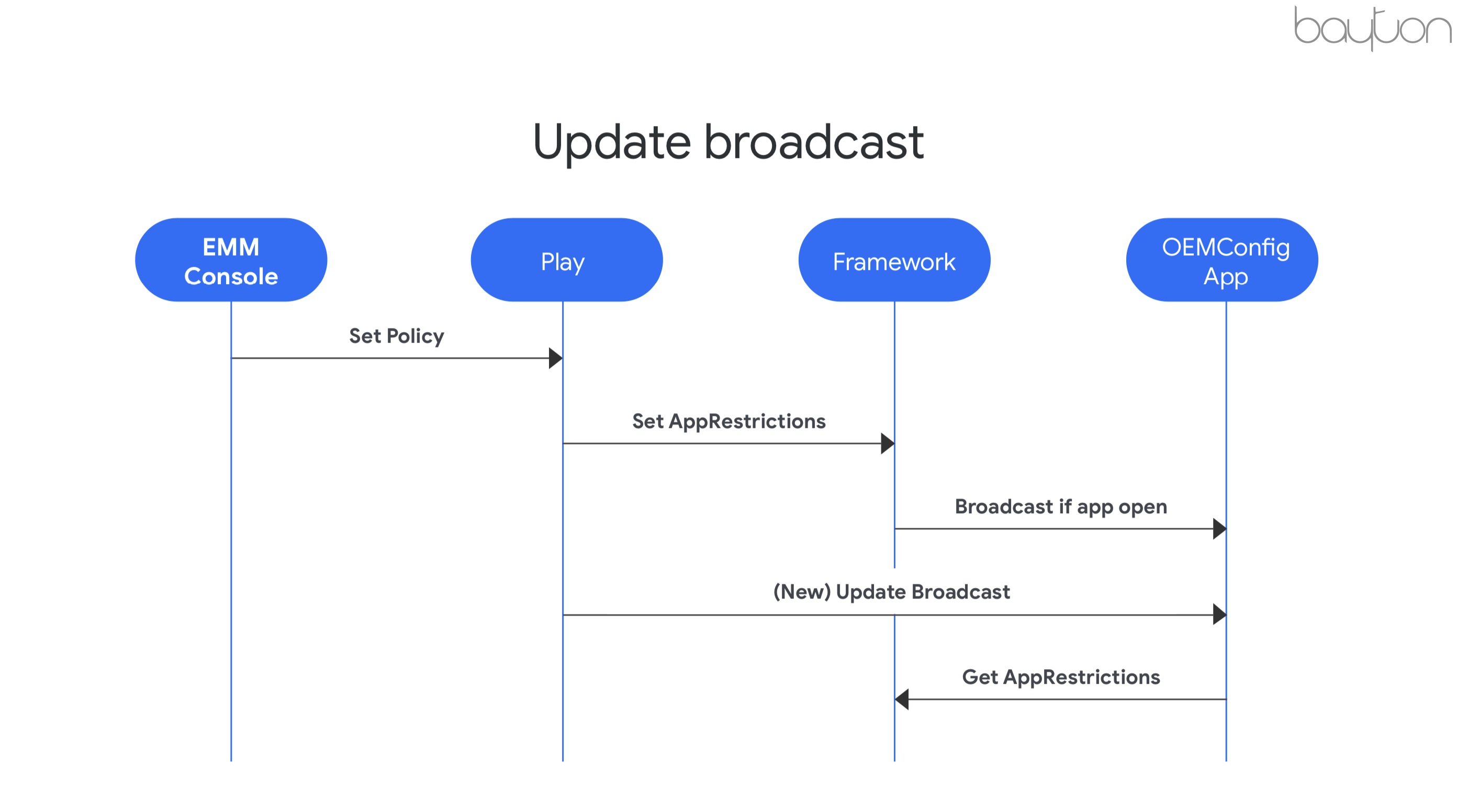
Rather than waiting for a managed config to arrive eventually, update broadcast will directly ping applications to say there’s a new managed config to apply irrespective of app state in a much more direct and reliable fashion.
Timeline update for DA Deprecation
#As Device Administrator Deprecation with Android Q nears, Google were nice enough to offer a much clearer picture on the timeline of true DADEP:
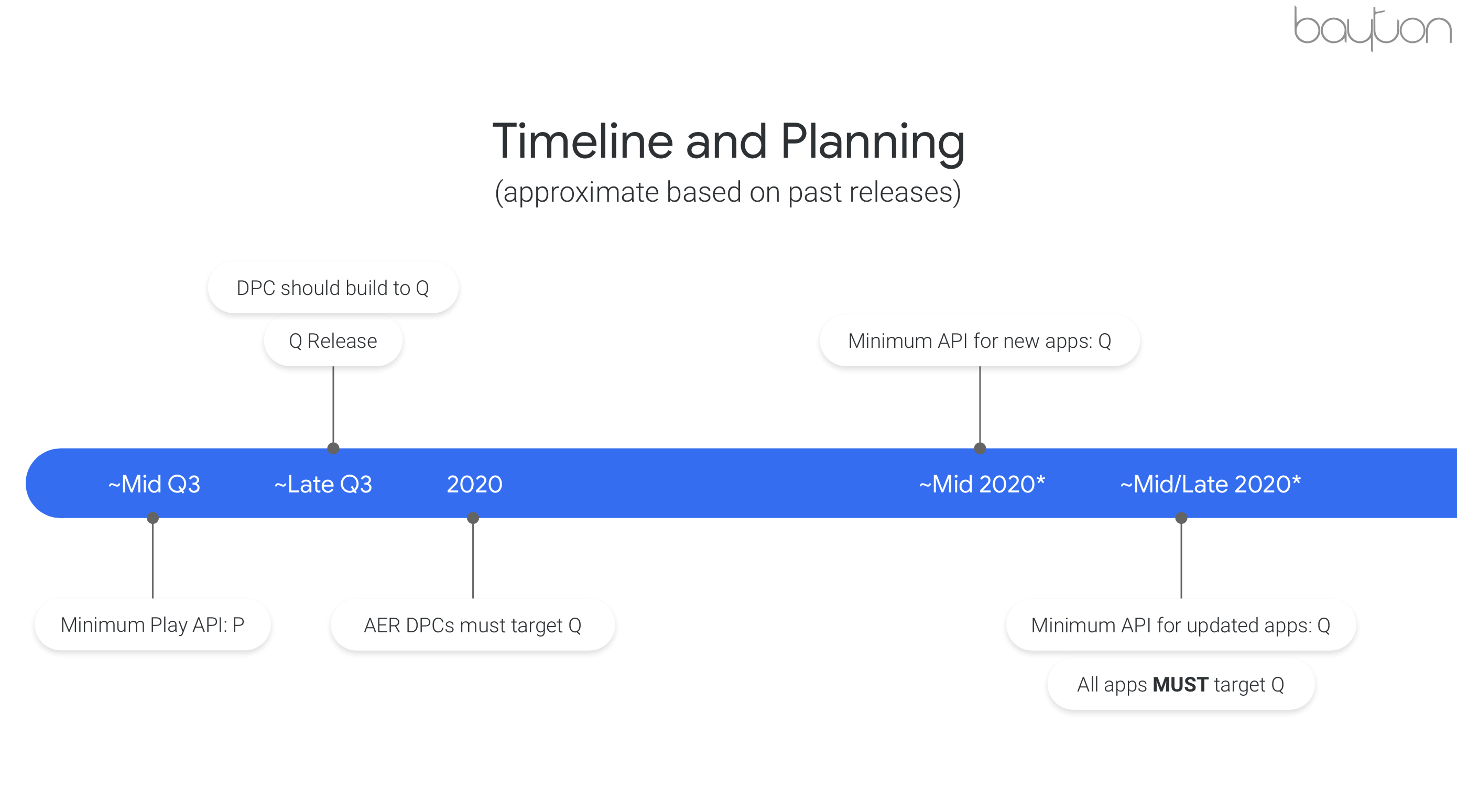
While technically Q deprecates DA features, the reality of it, as I’ve outlined already is far from the immediate, breaking change the likes of Apple are going for with iOS 13 and deprecation of unsupervised restrictions!
As above, the main milestones for DADep are:
- AER EMMs targeting API level 29 (Q) with their DPCs by 2020
- Google Play enforcing the minimum API level in mid 2020 for new apps, and late 2020 for updates.
Based on the clear timeline above, I went ahead and changed my own countdown to align with the AER EMM requirement of by 2020. It’s quite possible AER EMMs will target API 29 before this deadline, so I’d very much encourage orgs to reach out to vendors for a clear date in the diary to align with. Nobody should be sitting around waiting to see what deprecation will break though. Take a look at my considerations doc and get planning!
Android Enterprise Recommended
#Finally, we got a glimpse at what’s to come for AER across the board, including the long-anticipated AER for Carriers (and one the obvious requirements they’ll need to meet).
AER for devices: In Q, one of the most interesting requirements from my point of view is the new setup flow, as it’s flown mostly under the radar so far. I’d touched on it in my post dabbling with Q enterprise as both very good from a user education perspective, but equally the side effect of it slowing down provisioning. I’ll be testing it again with beta 4 in due course.
The requirement for the work tab is excellent. Too many devices today still don’t leverage it in Pie (some equally can’t manage to get a folder on the home screen either!) and given it’s improved usability it should absolutely be prioritised.
File-based encryption is great to see also. It’s popped up here and there over the last few releases but Google weren’t able to make it mandatory. Starting its enforcement through AER is a great stepping stone to mandate it in R (or later) globally.

AER for EMMs: Both mentioned ecosystem projects are exciting to see! First is support for OEMConfig, which though plenty of EMMs say they support, could definitely be improved.
The second is COPE, or COMP, or fully managed devices with work profiles, or work profiles on fully managed devices, or now personally enabled work devices..
Whatever it’s called, BlackBerry UEM adding support for COPE this week still brings the grand total number of vendors to support it to 3 across 4 EMMs. 2 years after Oreo’s release introducing this capability it’s incredible how few EMMs have integrated the solution set. I cannot wait for a mandate to come into force.

AER for Carriers: Long anticipated, AER for Carriers will require, amongst other things:
- Zero-touch enrolment
- Rapid approval for security maintenance releases
Disappointingly on the latter, limiting it only to SMRs means major platform upgrades will still likely be delayed by carriers I feel should have limited involvement with OS releases in the first place; it still makes sense therefore for organisations to opt for world wide SKUs where possible.
I look forward to seeing another uptick in zero-touch resellers coming on board as part of the AER validation process though!

Final thoughts
#Again most of my highlights here reflect what I personally saw at the summit. There were certainly other interesting announcements, one of which being the demo generator to aid in pitching Android Enterprise with pre-made content and topics to cover. It’s a great idea for partners needing a little inspiration or simply collateral.
In any case it was once more a fantastic event, that would only have been better if I was allowed again this year to liveblog!
I look forward to announcements finding their way into releases and getting hands on with a whole slew of new features. Until next time!
Photos
#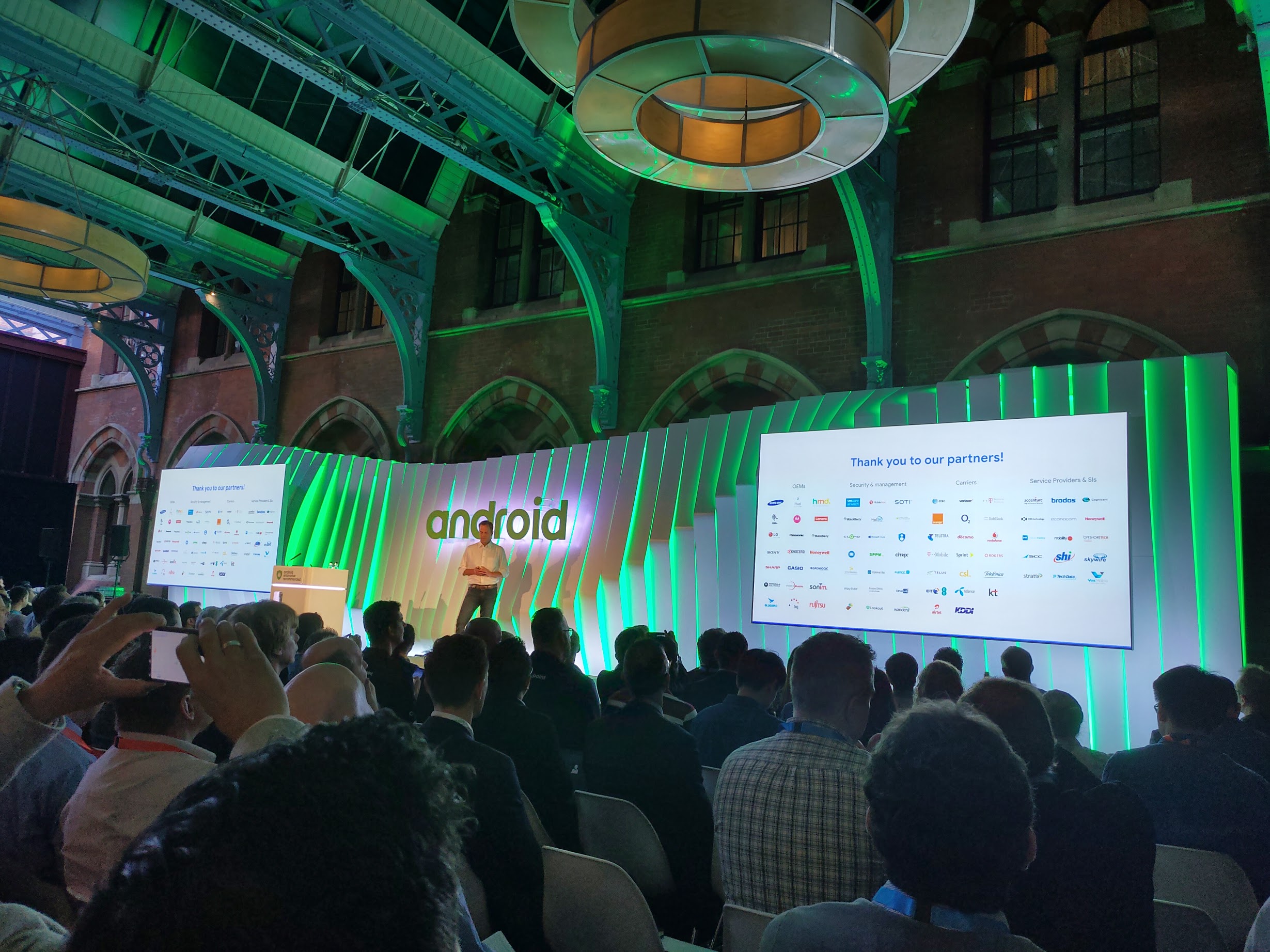
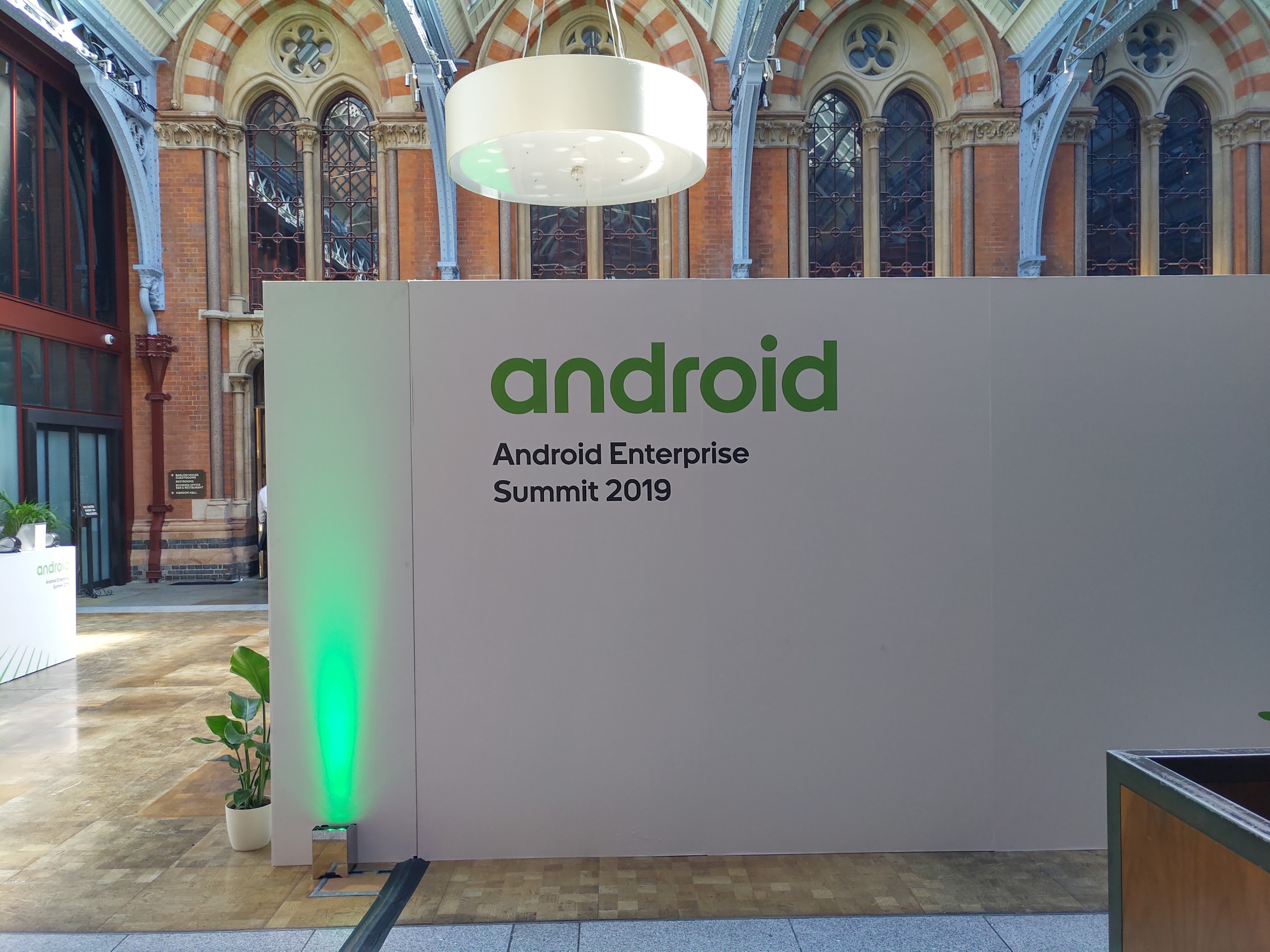
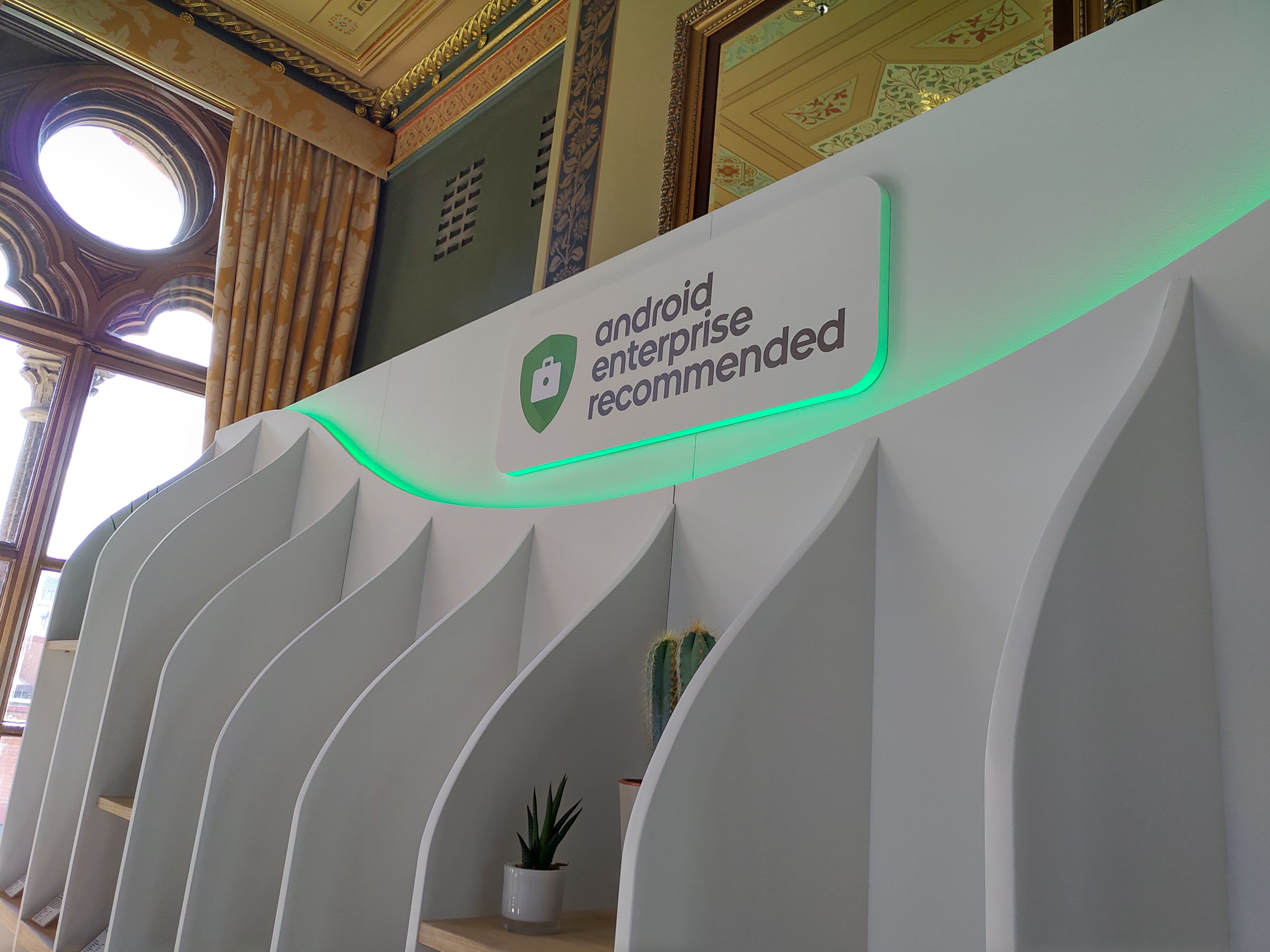


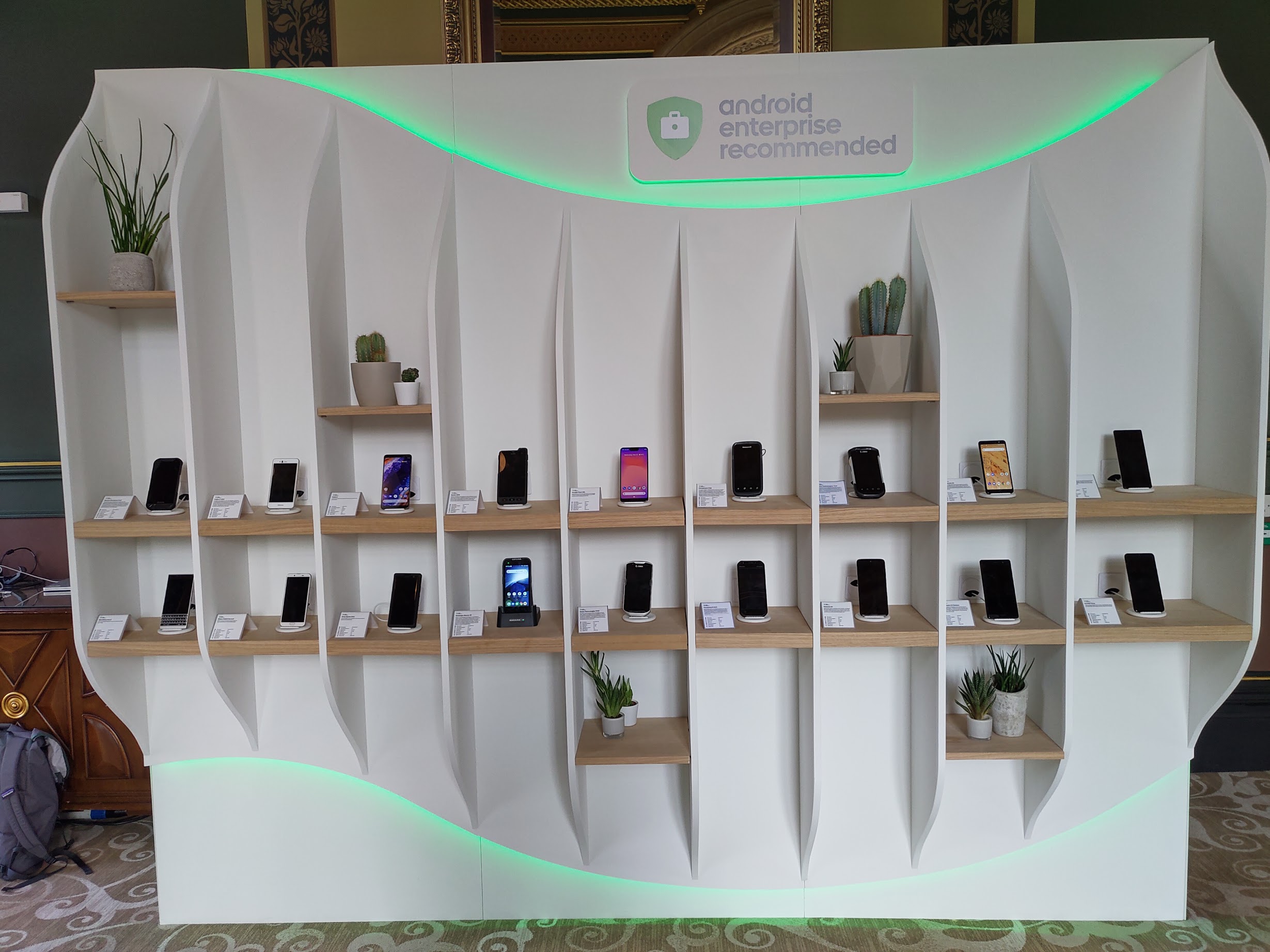



Articles
2025
- Google Play Protect is now the custom DPC gatekeeper, and everyone is a threat by default
- 12 deliveries of AE-mas (What shipped in Android Enterprise in 2025)
- The 12 AE requests of Christmas (2025 Edition)
- RCS Archival and you: clearing up the misconceptions
- Device Trust from Android Enterprise: What it is and how it works (hands-on)
- Android developer verification: what this means for consumers and enterprise
- AMAPI finally supports direct APK installation, this is how it works
- The Android Management API doesn't support pulling managed properties (config) from app tracks. Here's how to work around it
- Hands-on with CVE-2025-22442, a work profile sideloading vulnerability affecting most Android devices today
- AAB support for private apps in the managed Google Play iFrame is coming, take a first look here
- What's new (so far) for enterprise in Android 16
2024
- Android 15: What's new for enterprise?
- How Goto's acquisition of Miradore is eroding a once-promising MDM solution
- Google Play Protect no longer sends sideloaded applications for scanning on enterprise-managed devices
- Mobile Pros is moving to Discord
- Avoid another CrowdStrike takedown: Two approaches to replacing Windows
- Introducing MANAGED SETTINGS
- I'm joining NinjaOne
- Samsung announces Knox SDK restrictions for Android 15
- What's new (so far) for enterprise in Android 15
- Google quietly introduces new quotas for unvalidated AMAPI use
- What is Play Auto Install (PAI) in Android and how does it work?
- AMAPI publicly adds support for DPC migration
- How do Android devices become certified?
2023
- Mute @channel & @here notifications in Slack
- A guide to raising better support requests
- Ask Jason: How should we manage security and/or OS updates for our devices?
- Pixel 8 series launches with 7 years of software support
- Android's work profile behaviour has been reverted in 14 beta 5.3
- Fairphone raises the bar with commitment to Android updates
- Product files: The DoorDash T8
- Android's work profile gets a major upgrade in 14
- Google's inactive account policy may not impact Android Enterprise customers
- Product files: Alternative form factors and power solutions
- What's new in Android 14 for enterprise
- Introducing Micro Mobility
- Android Enterprise: A refresher
2022
- What I'd like to see from Android Enterprise in 2023
- Thoughts on Android 12's password complexity changes
- Google Play target API requirements & impact on enterprise applications
- Sunsetting Discuss comment platform
- Google publishes differences between Android and Android Go
- Android Go & EMM support
- Relaunching bayton.org
- AER dropped the 3/5 year update mandate with Android 11, where are we now?
- I made a bet with Google (and lost)
2020
- Product files: Building Android devices
- Google announce big changes to zero-touch
- VMware announces end of support for Device Admin
- Google launch the Android Enterprise Help Community
- Watch: An Android Enterprise discussion with Hypergate
- Listen again: BM podcast #144 - Jason Bayton & Russ Mohr talk Android!
- Google's Android Management API will soon support COPE
- Android Enterprise in 11: Google reduces visibility and control with COPE to bolster privacy.
- The decade that redefined Android in the enterprise
2019
- Why Intune doesn't support Android Enterprise COPE
- VMware WS1 UEM 1908 supports Android Enterprise enrolments on closed networks and AOSP devices
- The Bayton 2019 Android Enterprise experience survey
- Android Enterprise Partner Summit 2019 highlights
- The Huawei ban and Enterprise: what now?
- Dabbling with Android Enterprise in Q beta 3
- Why I moved from Google WiFi to Netgear Orbi
- I'm joining Social Mobile as Director of Android Innovation
- Android Enterprise in Q/10: features and clarity on DA deprecation
- MWC 2019: Mid-range devices excel, 5G everything, form-factors galore and Android Enterprise
- UEM tools managing Android-powered cars
- Joining the Android Enterprise Experts community
- February was an interesting month for OEMConfig
- Google launch Android Enterprise Recommended for Managed Service Providers
- Migrating from Windows 10 Mobile? Here's why you should consider Android
- AER expands: Android Enterprise Recommended for EMMs
- What I'd like to see from Android Enterprise in 2019
2018
- My top Android apps in 2018
- Year in review: 2018
- MobileIron Cloud R58 supports Android Enterprise fully managed devices with work profiles
- Hands on with the Huawei Mate 20 Pro
- Workspace ONE UEM 1810 introduces support for Android Enterprise fully managed devices with work profiles
- G Suite no longer prevents Android data leakage by default
- Live: Huawei Mate series launch
- How to sideload the Digital Wellbeing beta on Pie
- How to manually update the Nokia 7 Plus to Android Pie
- Hands on with the BQ Aquaris X2 Pro
- Hands on with Sony OEMConfig
- The state of Android Enterprise in 2018
- BYOD & Privacy: Don’t settle for legacy Android management in 2018
- Connecting two Synologies via SSH using public and private key authentication
- How to update Rsync on Mac OS Mojave and High Sierra
- Intune gains support for Android Enterprise COSU deployments
- Android Enterprise Recommended: HMD Global launch the Nokia 3.1 and Nokia 5.1
- Android Enterprise Partner Summit 2018 highlights
- Live: MobileIron LIVE! 2018
- Android Enterprise first: AirWatch 9.4 lands with a new name and focus
- Live: Android Enterprise Partner Summit 2018
- Samsung, Oreo and an inconsistent Android Enterprise UX
- MobileIron launch Android Enterprise work profiles on fully managed devices
- Android P demonstrates Google's focus on the enterprise
- An introduction to managed Google Play
- MWC 2018: Android One, Oreo Go, Android Enterprise Recommended & Android Enterprise
- Enterprise ready: Google launch Android Enterprise Recommended
2017
- Year in review: 2017
- Google is deprecating device admin in favour of Android Enterprise
- Hands on with the Sony Xperia XZ1 Compact
- Moto C Plus giveaway
- The state of Android Enterprise in 2017
- Samsung launched a Note 8 for enterprise
- MobileIron officially supports Android Enterprise QR code provisioning
- Android zero-touch enrolment has landed
- MobileIron unofficially supports QR provisioning for Android Enterprise work-managed devices, this is how I found it
- Hands on with the Nokia 3
- Experimenting with clustering and data replication in Nextcloud with MariaDB Galera and SyncThing
- Introducing documentation on bayton.org
- Goodbye Alexa, Hey Google: Hands on with the Google Home
- Restricting access to Exchange ActiveSync
- What is Mobile Device Management?
- 8 tips for a successful EMM deployment
- Long-term update: the fitlet-RM, a fanless industrial mini PC by Compulab
- First look: the FreedomPop V7
- Vault7 and the CIA: This is why we need EMM
- What is Android Enterprise (Android for Work) and why is it used?
- Introducing night mode on bayton.org
- What is iOS Supervision and why is it used?
- Hands on with the Galaxy TabPro S
- Introducing Nextcloud demo servers
- Part 4 - Project Obsidian: Obsidian is dead, long live Obsidian
2016
- My top Android apps 2016
- Hands on with the Linx 12V64
- Wandera review 2016: 2 years on
- Deploying MobileIron 9.1+ on KVM
- Hands on with the Nextcloud Box
- How a promoted tweet landed me on Finnish national news
- Using RWG Mobile for simple, cross-device centralised voicemail
- Part 3 – Project Obsidian: A change, data migration day 1 and build day 2
- Hands on: fitlet-RM, a fanless industrial mini PC by Compulab
- Part 2 - Project Obsidian: Build day 1
- Part 1 - Project Obsidian: Objectives & parts list
- Part 0 - Project Obsidian: Low power NAS & container server
- 5 Android apps improving my Chromebook experience
- First look: Android apps on ChromeOS
- Competition: Win 3 months of free VPS/Container hosting - Closed!
- ElasticHosts review
- ElasticHosts: Cloud Storage vs Folders, what's the difference?
- Adding bash completion to LXD
- Android N: First look & hands-on
- Springs.io - Container hosting at container prices
- Apple vs the FBI: This is why we need MDM
- Miradore Online MDM: Expanding management with subscriptions
- Lenovo Yoga 300 (11IBY) hard drive upgrade
- I bought a Lenovo Yoga 300, this is why I'm sending it back
- Restricting access to Exchange ActiveSync
- Switching to HTTPS on WordPress
2015
2014
- Is CYOD the answer to the BYOD headache?
- BYOD Management: Yes, we can wipe your phone
- A fortnight with Android Wear: LG G Watch review
- First look: Miradore Online free MDM
- Hands on: A weekend with Google Glass
- A month with Wandera Mobile Gateway
- Final thoughts: Dell Venue Pro 11 (Atom)
- Thoughts on BYOD
- Will 2014 bring better battery life?
- My year in review: Bayton.org
- The best purchase I've ever made? A Moto G for my father
2013
2012
- My Top Android Apps 12/12
- The Nexus 7 saga: Resolved
- Recycling Caps Lock into something useful - Ubuntu (12.04)
- The Nexus 7 saga continues
- From Wows to Woes: Why I won't be recommending a Nexus7 any time soon.
- Nexus7: What you need to know
- Why I disabled dlvr.it links on Facebook
- HTC Sense: Changing the lockscreen icons from within ADW
2011
- Push your Google+ posts to Twitter and Facebook
- Using multiple accounts with Google.
- The "Wn-R48" (Windows on the Cr-48)
- Want a Google+ invite?
- Publishing to external sources from Google+
- Dell Streak review. The Phone/Tablet Hybrid
- BlueInput: The Bluetooth HID driver Google forgot to include
- Pushing Buzz to Twitter with dlvr.it
- Managing your social outreach with dlvr.it
- When Awe met Some. The Cr-48 and Gnome3.
- Living with Google's Cr-48 and the cloud.
- Downtime 23-25/04/2011
- Are you practising "safe surfing"?
- The Virtualbox bug: "Cannot access the kernel driver" in Windows
- Putting tech into perspective
2010
- Have a Google Buzz Christmas
- Root a G1 running Android 1.6 without recovery!
- Windows 7 display issues on old Dell desktops
- Google added the Apps flexibility we've been waiting for!
- Part I: My 3 step program for moving to Google Apps
- Downloading torrents
- Completing the Buzz experience for Google Maps Mobile
- Quicktip: Trial Google Apps
- Quicktip: Save internet images fast
- Turn your desktop 3D!
- Part III - Device not compatible - Skype on 3
- Swype not compatible? ShapeWriter!
- Don't wait, get Swype now!
- HideIP VPN. Finally!
- Google enables Wave for Apps domains
- Aspire One touch screen
- Streamline XP into Ubuntu
- Edit a PDF with Zamzar
- Google offering Gmail addresses in the UK
- Google Wave: Revolutionising blogs!
- Hexxeh's Google Chrome OS builds
- Update: Buzz on Windows Mobile
- Alternatives to Internet Explorer
- Wordress 3.0 is coming!
- Skype for WM alternatives
- Browsing on a (data) budget? Opera!
- Buzz on unsupported mobiles
- Buzz on your desktop
- What's all the Buzz?
- Part II: Device not compatible - Skype on 3
- Part I - Device not compatible - Skype on 3
- Dreamscene on Windows 7
- Free Skype with 3? There's a catch..